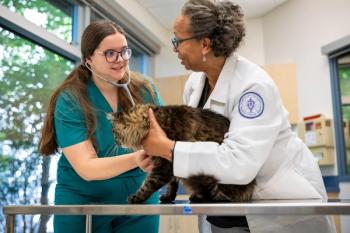
|Articles|August 17, 2010
Case 3, Answer 7b
Advertisement
Correct. Surgical removal of the affected gland is often curative. Most dogs will only have one enlarged gland, and the other three will be atrophied. Remember to always send the tissue in for histopathologic examination as there is a chance the mass may be a carcinoma. The patient will require close postoperative monitoring of hypocalcemia because the contralateral glands are often atrophied and not functioning properly.
Advertisement
<<
Newsletter
From exam room tips to practice management insights, get trusted veterinary news delivered straight to your inbox—subscribe to dvm360.
Advertisement
Advertisement
Advertisement
Trending on dvm360
1
Mental health and the use of AI in veterinary medicine
2
Nonpharmacologic ways of managing pain and separation anxiety in dogs
3
Education partnership provides more global learning opportunities
4
Texas Tech to launch its first food animal residency program amid rural vet shortage
5




